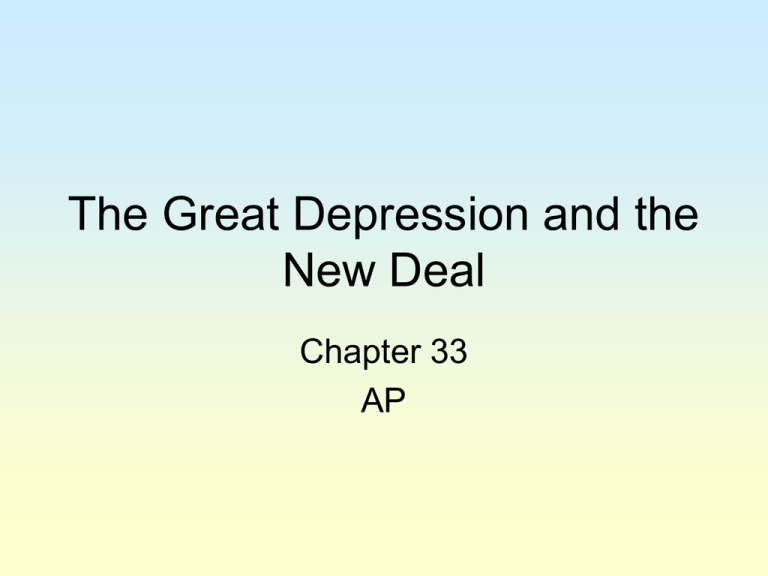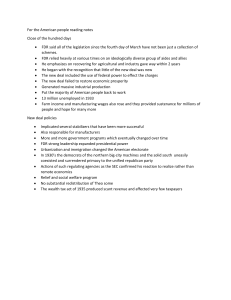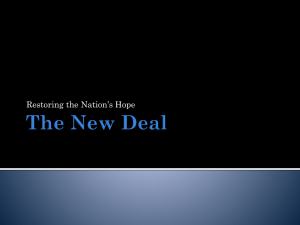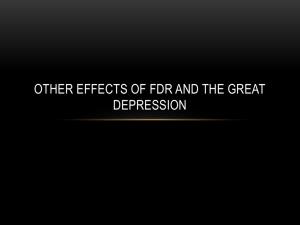The Great Depression and the New Deal Chapter 33 AP
advertisement

The Great Depression and the New Deal Chapter 33 AP Who was FDR? • Wealthy New Yorker • Harvard • Columbia Law School • Values: – Civic duty – Competitive athletics – Public service FDR? • Anna Eleanor Roosevelt • Democrat • NY State Senate • Asst. Sec of Navy • Dem candidate for VEEP in 1920 • 1921 – Polio • Gov. of NY What were FDR’s achievements as governor of NY? • • • • • • • Reform Unemployment insurance Strengthened child labor laws Tax relief for farmers Pensions for the old Depression – increased public works Temporary Emergency Relief Administration The Election of 1932 Inauguration Day 1933… How did FDR restore confidence? • • • • • • Inaugural message… Roots of New Deal… Fireside Chats… “Bank Holiday” Emergency Banking Act… FDIC… Fireside Chat What was Keynesian Economics? • John Maynard Keynes • To get economy going: – Lower taxes – Spend money – Run up deficit • “pump priming” • Gov’t could step aside and cut expenses • Let private business take over “Prime the Pump”… The Economy Act? • FDR had promised to balance the budget • Asked Congress to cut gov’t salaries, pensions, and take steps to reduce deficit • Legalized light beer and wine • 21st Amendment What were the key components of the First Hundred Days? • • • • • • • Civilian Conservation Corps Gold Reserve Act Federal Emergency Relief Act Tennessee Valley Authority Agricultural Adjustment Act National Industrial Recovery Act Federal Securities Act What was the TVA? • • • • • • Hydroelectric network Cheap electric power Flood control Recreational facilities Soil conservation Improved social and economic well-being of underdeveloped region Stringing Rural TVA Transmission Line What was the AAA? • Producers received subsidies to take acreage out of production • Tax on food processors – financed subsidies • Cost passed on to the Am. People in terms of higher costs • Goal: parity to restore farm prices at 19091914 levels How successful was the AAA? • Successes: – Raised farm income • Failures: – Hurt tenant farmers and sharecroppers – Negative affect of crop destruction • Southern Tenant Farmers Union – Opposed evictions – Strikes to raise farm wages What was the National Industrial Recovery Act? • Reflects back to trade assoc. of Hoover era • Public Works Administration - $3.3 billion – Harold Ickes – priming the pump • Drafted codes for fair competition – Set production limits – Prescribed wages – Forbade price cutting and unfair competitive practices – NRA administered codes Why did organized labor like the NIRA? • Section 7a –Prohibited employers from discriminating against union members –Affirmed workers legal right to organize and bargain collectively Why did the NIRA bog down? • Too cumbersome – Code violations – Used to restrain competition and keep prices high • Unpopular – Small businesses said it favored large co. • Declared unconstitutional – Gave regulatory powers to the Pres that should have gone to Congress – Regulated commerce within the states How did the American people respond to the New Deal? • Very popular • 1934 election – Democratic party increased its majority in Congress Why was Roosevelt challenged from the Right and Left? • Business leaders saw the New Deal as a threat to capitalism • Right too far left • Left not far enough Who Challenged from the Right? • American Liberty League - Al Smith (grew conservative) - Top corporate figures - U.S. Chambers of Commerce • Called New Deal extravagant, socialistic, and unconstitutional. • Roosevelt's style of governance was compared to that of Stalin, Hitler, and Mussolini. • New Deal programs restricted individual freedom Socialism • FDR was a “traitor to his class” Al Smith The American Liberty League Father Charles Coughlin • Radio priest with an audience of 40 million • Royal Oak, Michigan • At first supported New Deal • Later called FDR “a great betrayer and liar” • Anti-Semitic • Wanted to nationalize the banks • National Union of Social Justice – supported by urban middle class Who Challenged from the Left? • • • • Upton Sinclair Francis Townsend Huey Long American Labor Upton Sinclair • • • • • • Ran for Gov. of California – 1934 EPIC – End Poverty in California $50/month pension for all poor over 60 Government run system of production Won the Democratic primary Lost in close election Francis Townsend • California retired physician • $200/month to all retirees over 60 • Must spend the entire amount in 30 days • Help elderly and stimulate the economy Huey Long • LA Governor – political machine – controlled the state • 1932 Senator • Share Our Wealth • 100% tax on all incomes over $1million • Appropriation of all incomes over $5 million Every Man a King • Give every American a comfortable income, house, car, old –age pension, education • Aspired to the presidency assassinated Labor Movement • Unemployment councils organized by the communist party • Marches and rallies demanding public works and relief • Minneapolis – Teamster strike – violence against the workers unites the people • San Francisco – general strike in response to violence against the Longshoremen • Power of labor solidarity and mass protest How did FDR respond? • Economy had not rebounded as FDR had thought it would – rose 25% from 1933 • Millions still jobless • 2,000 strikes • SECOND NEW DEAL - more reform – more relief – social welfare benefits move further to the left What were the goals of the Second Hundred Days? • Expanding federal relief • Emergency Relief Appropriation Act – 1935 • Works Progress Administration (WPA) • National Youth Administration • Public Works Administration • National Debt doubles – a means to an end Emergency Relief Appropriation Act - 1935 • Granted FDR $5 billion to spend as wished • Set up the WPA • Harry Hopkins Works Progress Administration • Relief assistance from federal government to individuals • Provided work for the jobless rather than a hand – out • 8 years – 8 million people employed • $11 billion economy Public works • 650,000 miles of roads • 124,000 bridges • 125,000 schools, post offices, etc. Field House at LSU – WPA project Federal Writers Project • Out of work authors wrote state guides, histories of ethnic and immigrant groups • Transcribed handwritten legal documents from Salem Witchcraft trials • Interviewed 2,000 ex-slaves Federal Theatre Project • Put unemployed actors to work • Brought live theatre to small town America Other Work Relief Projects • National Youth Administration – part – time work for high school and college youths • Public Works Administration – Harold Ickes – Spent $4 billion on 24,000 building projects – bridges, college libraries, Grand Coulee Dam • FDR reluctantly tolerated deficit spending as the price of other New Deal Goals Other Projects • Artists designed posters - taught painting – murals • Historians employed • Musicians formed symphonies Why did the Second New Deal turn left? • FDR tried to appeal to all – gave up • Conservative criticism • Offered a program geared to the needs of the poor, disadvantaged and laboring masses • Feared Coughlin, Townsend, and Long would have a popular appeal Resettlement Administraton • Loans to small framers to buy farms • Allow tenant farmers and sharecropper tilling exhausted soil to resettle National Labor Relations Act – Wagner Act • • • • 1935 Guaranteed collective bargaining rights Permitted closed shops Outlawed management spying on unions and blacklisting union agitators • National Labor Relations Board created to supervise union elections and to monitor unfair labor practices Social Security Act • 1935 • Old age pension • Survivor’s benefits for victims of industrial accidents • Unemployment insurance • Aid to dependent mothers and children, blind, crippled • Paid for by taxes on wages • Established the principle of government responsibility for public welfare Revenue Act of 1935 • Raised personal taxes and boosted taxes on gifts and estates • Expressed class conscious spirit of the Second New Deal What gains were made by labor during the New Deal? Committee for Industrial Organizations (CIO) • 1935 • Organized unskilled labor • Steel workers, auto, rubber, textile mills • Welcomed all workers regardless of race, gender or skill • 1936 steel workers won recognition from U.S. Steel – wage increase and 40 hr. week United Auto Workers • Organized by Walter Reuther • Struck against GM • Sit – down strike of Fisher Body in Flint – 1936-37 • GM called in the police, sent spies to union meetings, threatened to fire workers • FDR and governor of MI refused to send in troops • Feb., 1937 – GM recognized the UAW How did the American People respond to the New Deal? • Election of 1936 – Republican candidate – Alf Landon of Kansas – FDR – only issue in the campaign – carried every state but Maine and Vermont – Congress – increased the Democratic margin What was the New Democratic Coalition? • • • • • • • Solid South Large cities Midwestern farmers Urban immigrants Organized labor Northern blacks Women How did the Supreme Court react to the New Deal? • Schechter v. U.S. – NRA unconstitutional because it gave legislative power to the executive and regulated intrastate commerce • Butler v. U.S. – AAA unconstitutional – tax used to finance was not constitutional How did FDR propose to change the Supreme Court? • “Nine old men” • 6 over 70 • Appoint one new justice for each one over 70 • Excuse – help older justices keep up with the work load • Criticized by members of own party for “court packing” How was the issue resolved? • Conservative justices began to retire • Appointed 4 new justices • Social Security, TVA, and Wagner Act were all upheld • Weakened FDR’s relationship with Congress Evaluation of New Deal? • • • • • Fair Labor Standards Act – minimum wage Lasting monuments ….. Successful programs ….. Changed expectations …. Changed government role …





